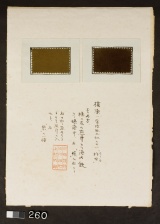Difference between revisions of "Nara (Oak) - left (260 L)"
Jump to navigation
Jump to search
(username removed) |
m (MDerrick moved page Nara - left (260 L) to Nara (Oak) - left (260 L) without leaving a redirect) |
||
| (One intermediate revision by one other user not shown) | |||
| Line 5: | Line 5: | ||
| 260 | | 260 | ||
|- | |- | ||
| − | ! scope="row"| | + | ! scope="row"|Uemura number / title |
| − | | | + | | ; "Haze-some 25" |
|- | |- | ||
! scope="row"|Folder location | ! scope="row"|Folder location | ||
| Line 44: | Line 44: | ||
| ash water (separate bath) | | ash water (separate bath) | ||
|- | |- | ||
| − | ! scope="row"| | + | ! scope="row"|Uemura's notes |
| − | | This color is what was called as "Narashiba ( | + | | This color is what was called as "Narashiba ()" in the Hitachinokuni-fudoki (), from 721 AD, Japan. With the left sample, the dyeing procedure was: 1) dye bath; 2) mordant bath; and 3) ash water bath. The resultant color on the right sample was similar to those dyed with acorns. |
|- | |- | ||
| − | ! scope="row"| | + | ! scope="row"|Uemura's date |
| Kyoto Murasakino | | Kyoto Murasakino | ||
|} | |} | ||
| − | [[Category: | + | [[Category:Uemura dye archive]] |
Latest revision as of 17:48, 23 June 2020
| Museum number | 260 |
|---|---|
| Uemura number / title | ; "Haze-some 25" |
| Folder location | 4th shelf |
| Sample location | left (260 L) |
| Fiber type | silk |
| Color | yellow brown |
| Dyestuff (Japanese common name) | 楢 : Nara |
| Dye (English common name) | a type of oak tree |
| Dyestuff (botanical name) | Quercus serrata Murray |
| Plant part | bark / dried (?) |
| Dyestuff extraction | boiled in water |
| Auxiliary agent in dye bath | - |
| Mordant | iron |
| Other auxiliary agent | ash water (separate bath) |
| Uemura's notes | This color is what was called as "Narashiba ()" in the Hitachinokuni-fudoki (), from 721 AD, Japan. With the left sample, the dyeing procedure was: 1) dye bath; 2) mordant bath; and 3) ash water bath. The resultant color on the right sample was similar to those dyed with acorns. |
| Uemura's date | Kyoto Murasakino |
